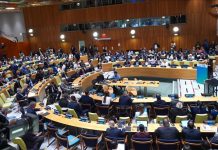Africa-Press – Lesotho. An intra-regional trade agreement bringing together 26 countries in Africa has come into force after 13 years of negotiations.
The Tripartite Free Trade Area (TFTA), a pact bringing together partner states of the Common Market for Eastern and Southern Africa (Comesa), the East African Community (EAC) and the Southern African Development Community (SADC) took off on Thursday after Angola joined.
This brings the total number of Instruments of Ratification deposited to 14, meeting the number required for the Agreement to enter into force out of the 29 member States.
Based on three main pillars of market integration including trade liberalisation, infrastructure development and industrial development seeks to improve trade within the continent which is currently at a paltry 20 percent.
It will fast-track a free trade area and arrangements for the movement of business persons; focus on enhancing connectivity and reducing business costs; and create a supportive environment by improving regulatory and legal frameworks.
It intends to add value, diversify industries, increase productivity and competitiveness, and implement programmes for structural change.
Statistics show that Tripartite countries import more than 99 percent of similar products exported by the EAC, indicating that the EAC has a considerable market opportunity to grow its exports under the TFTA preferential tariff regime, for products such as vegetables, meat, bovine, pasta, among others.
The trade deal is set to eliminate tariffs on 100 percent of goods, stimulating economic growth, industrialisation, and sustainable development.
It complements the AfCFTA, which aims to eliminate tariffs on 90 percent of goods in a market of over 1.3 billion people.
In a press statement, the East Africa Business Council (EABC) applauded the commencement of TFTA, with the acting executive director Adrian Njau saying “Our dream is to see businesses start trading under the TFTA preferential tariff”.
He explained that in 2022, EAC exports to SADC amounted to $3.79 billion, while imports totaled $3.9 billion.
EAC exports to Comesa were $6 billion, with imports at $4.7 billion, according to the EAC Trade and Investment Report 2022.
EAC Partner States trade more with Tripartite member states compared to the rest of Africa due to overlapping membership in SADC and COMESA, where they benefit from preferential tariff treatment.
Tanzania and DRC are in SADC, while Kenya, Uganda, Burundi, and Rwanda are in COMESA.
Njau lauded Burundi, Rwanda, Kenya, and Uganda for ratifying the TFTA agreement and urged the other EAC Partner States of Somalia, DRC, South Sudan and Tanzania to expedite their ratifications to trade under preferential treatment with countries not in the same bloc.
“Kenya can now export to South Africa under TFTA preferential tariff treatment. EAC countries should not fear competition from South Africa and Egypt, as other EAC countries already trade with them under Comesa and SADC.”
He noted that EABC, along with Comesa and SADC business councils, formed the African Tripartite Business Council to champion the integration of private sector policy proposals into the TFTA in Kigali 2022.
Addressing competitiveness and supply-side constraints, such as efficiency costs, quantity, quality, and high transport and logistics costs, is important for the EAC to seize the TFTA 800 million market.
Clear sanctions for non-implementation are also central to the success of the TFTA.
The 29 Tripartite Member States represent 53 percent of the African Union’s membership, more than 60 percent of continental GDP ($1.88 trillion), and a combined population of 800 million.
The private sector must understand the trade instruments of rules of origin, standards, and the dispute settlement mechanism under the TFTA.
For More News And Analysis About Lesotho Follow Africa-Press






